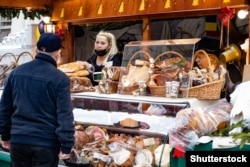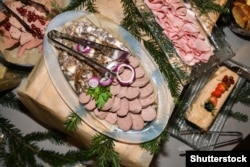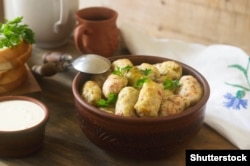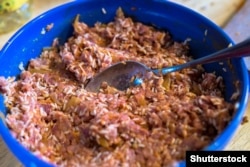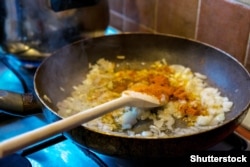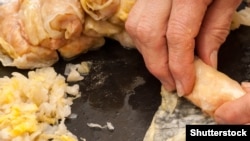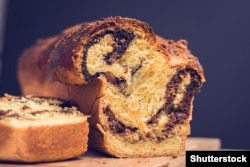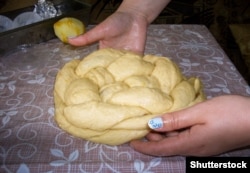As part of an occasional series on how the end-of-year holidays are observed in our broadcast region, we talked to Eugen Tomiuc from RFE/RL's Central Newsroom about the way Christmas is celebrated in Romania. Although the festival was suppressed in his country for decades by a communist regime, Tomiuc says many old Christmas traditions have come back strongly in the years since Nicolae Ceausescu’s government was toppled in December 1989. We look at some of these ancient customs and also share recipes for two traditional Romanian specialties that are an integral part of the annual Christmas feast.
Like their Bulgarian neighbors, Romanians are unusual in that they celebrate Christmas Day on December 25 despite mostly being adherents of Orthodox Christianity, which normally observes this festival two weeks later.
This is a relatively recent development, however, dating back only to the formation of a new Romanian state after the end of World War I.
“The Gregorian calendar…was introduced in Romania in 1919 after the formation of Greater Romania through the unification of Transylvania, Bessarabia, and Bukovina with the Romanian kingdom,” says Romanian-born journalist Eugen Tomiuc from RFE/RL’s Central Newsroom.
“The Orthodox Romanian kingdom and Bessarabia -- under Russian occupation since 1812 -- celebrated Christmas according to the Julian calendar, some 14 days later than the religiously mixed Transylvania and Bukovina, which were both under Hapsburg rule and used the Gregorian calendar because Orthodox Christianity was not the official religion.”
Interestingly, Romanians still celebrate Easter according to the Orthodox tradition, but Christmas is now observed at the same time as their Western counterparts, something that is not without a certain political resonance, according to Tomiuc.
In a way, he says, “celebrating Christmas on December 25 marked both a further step toward the West for Romania as well as a fresh symbol of reunification.”
For several decades, however, Romanians didn’t actually “officially” celebrate Christmas on any day at all, because it was effectively prohibited by the atheist communist government.
“Christmas was not only poor -- it was virtually banned,” says Tomiuc. “Christmas trees were available, but they were called ‘winter trees.’ Likewise, Santa Claus, or Father Christmas, was turned by the communists into a Russian import -- ‘Father Frost.’ Bitterly joking, some would say on the 25th, ‘I’ve got no present, because I was visited by Father Frost, not by Father Christmas!’
“Still, people would celebrate Christmas privately,” he adds. “But without any pomp, since there were no days off for the festival.”
Given the economic turmoil of communist dictator Nicolae Ceaușescu’s final years in power, there wasn’t even much cause for these private celebrations.
“Penury was the only plentiful thing, along with cold and darkness during the last 10 years of communism,” says Tomiuc. “In my hometown, like pretty much everywhere, food, energy, hot water, and heating were 'rationed,' meaning scarce.
“Our food rations were half a liter of cooking oil per person per month; five eggs; 1 kilo of sugar; 1 kilo of flour/half a loaf of bread. Meat? One kilo of pork and 1 kilo of beef per person three times a year: on May Day, August 23 (a national holiday celebrating Romania’s liberation from fascism), and ‘New Year’ in December.”
For many Romanians like Tomiuc, who grew up under communism, Christmas will also always be associated with the dramatic events of December 1989, when Ceausescu’s regime was finally toppled during a violent revolution.
“Sometimes, amid the soothing sound of our wonderful carols, I still hear a burst of machine-gun fire,” he says, recalling the “tattered celebration” Romanians held on Christmas Day that year, the same date on which Ceausescu and his wife, Elena, were summarily executed.
“I will always remember two things,” says Tomiuc. “On the one hand, the…unheard-of sound of Christmas carols on the newly free radio and television on December 24; on the other hand, the heartbreaking footage of hundreds of fresh crosses in the frozen snow in cemeteries across Romania…”
In the ensuing decades, however, “Christmas has long retaken its place in the Romanian psyche,” says Tomiuc. Although this means the country is “swamped by the same consumerism” as many other places, it also means “people are free to observe their sacred traditions.”
Typically for Orthodox Christians, these traditions are supposed to include a pre-Christmas fast of 40 days (Postul Craciunului), but Tomiuc says the rules are “rather permissive, with many days when eating fish, oil, and even wine is allowed.”
And, even on those days when meat, milk, cheese, and eggs are off the menu, there is still a lot of culinary variety.
“Foods allowed during fasting are plenty and tasty, with traditional recipes that would leave any vegetarian with a watering mouth,” says Tomiuc.
Permitted delicacies at this time of year include mushroom ragout with mamaliga, a kind of polenta that Romanians have been using as a staple for centuries. Another favorite for fasting days is ciorba de fasole, a nourishing white bean soup that is usually flavored with lovage in southern Romania or tarragon in Transylvania. Even the humble potato can be boiled or baked and seasoned with zeama de varza, the pickled Romanian cabbage juice that Tomiuc describes as an “intricate Romanian delicacy,” which is synonymous with the Christmas season.
This period of abstinence reaches its conclusion the day before Christmas on December 24 with post negru, a so-called “dark fast” where not even water is allowed. Strict adherents to tradition eat a meal of boiled wheat grains sweetened with honey and garnished with some seeds and fruit on Christmas Eve, which is known as Ajunul Craciunului in Romanian, deriving from the Romanian word ajun, meaning “fasting.”
Although, strictly speaking, religious Romanians officially have their main Christmas celebrations on December 25-27, Christmas Eve is also hugely important and is associated with a number of customs. This is the day on which Romanians are supposed to decorate their Christmas tree and, says Tomiuc, “it is also the time for unwrapping presents, unlike in the United States where kids and adults alike must wait until morning to see if Santa has brought what they wished for.”
One of the most famous things associated with the festivities is the so-called colindatul, or carol singing. Starting on the first day of Christmas, this involves children but also adults roaming the streets of towns and villages in traditional dress, asking for permission to sing at each house.
“They sing superb traditional religious Christmas carols,” says Tomiuc. Many of the songs are about the star that presaged Jesus’s birth, so the carolers often carry an ornate, handcrafted star fixed on a pole to signify this as they wander the streets, a custom known as a merge cu Steaua, or “walking with the Star.”
Hosts open their doors to the colindatori and treat them to some of Romania’s celebrated national dishes that are traditionally eaten at this time of year, such as sarmale (pickled cabbage rolls stuffed with meat), cozonac (a sweet roll, usually with a walnut filling, although poppy seeds or raisins can also be used), and poale-n brau, a kind of cheese pie that is thought to have originated in Moldova.
Usually, the carol singing becomes an increasingly vocal and merry affair, says Tomiuc, because, more often than not, the hosts tempt the adult carolers with homemade wine, which is frequently mulled, and tuica fiarta, a flavorsome plum brandy boiled with a little honey or ground pepper. Traditionally, not opening the door to parties of colindatori will mean bad luck for the year to come, so most houses at this time of year are well-stocked with this “renowned winter warmer” and other treats.
Like many other places, Romania’s tradition of carol singing is much more widely observed in the countryside nowadays.
“In the big cities, it is more rare to see colindatori,” says Tomiuc. “Although in places like Bucharest, poor children sometimes board trams and buses and sing in the hope that passengers will spare some change.”
Other old traditions that are often meticulously observed in rural areas include sweeping your floors inwards on December 24, from the door to the middle of the room, so any luck will not have a chance to escape. Beginning on the feast of St. Ignatius of Antioch four days earlier, it’s also customary for “no laundry to be done and no wool to be spun” until the feast of the Epiphany on January 6.
December 20 is also the day on which Romanians are traditionally supposed to kill the Christmas pig to get started on preparing the numerous pork-based dishes that are the star attraction once the main seasonal feast finally gets under way on December 25.
“The pig is the undisputed king of the Christmas dinner,” says Tomiuc, and it provides many households with “meters of sausages, raw and smoked, blood puddings, bucketfuls of melted fat that are used to preserve fried pork chops for months, and strips of seared pork skin called sorici, which are a sought-after snack in Romania.”
Naturally, the pork from the pig is also the basis for many delicious dishes on Christmas Day, when the fast ends and "the levee finally breaks," as Tomiuc puts it.
These porcine Yuletide delights include roast gammon and pork chops, “but nowhere is the pig’s meat more tasty than in what’s widely accepted as Romania’s national dish,” says Tomiuc: “sarmale.”
Similar to many Middle Eastern dishes of stuffed vine leaves, sarmale are a uniquely Romanian version of the concept, comprising pickled cabbage leaves filled with a mixture of minced pork and beef.
It is widely eaten on various holidays in Romania but is associated mainly with the end-of-year festivities, where it is usually the centerpiece of everyone’s Christmas table.
How To Make Sarmale
Ingredients
1 kg combined ground pork and beef meat
1/2 cup rice
1 large onion chopped
1 large, pickled cabbage (varza murata)
A couple of slices of smoked bacon chopped into pieces (or use chunks of smoked pork leg if you want to make it the traditional Transylvanian way)
A few sprigs of dried thyme
2 tbsp tomato puree
Mixed herbs, salt, and pepper to taste
Method
1. Chop the onion and saute it for a couple of minutes in hot cooking oil before adding the rice. Then add 2 tablespoons of tomato puree and let the mixture simmer, adding a bit of water from time to time. Do not cook the rice all the way through but leave it half-done or al dente.
2. Mix the ground meat in a large bowl. Add the sauteed onion-and-rice mixture along with some dried mixed herbs, salt, and pepper to taste. Mix well with your hands. (You can use rubber gloves to avoid dried meat sticking to your palms.)
3. Gently peel individual leaves from the cabbage, making sure not to rip or tear them. Only the larger leaves of the cabbage are needed for rolling the sarmale. You can chop the remainder of the cabbage into rough pieces, which will be used later when cooking the meal.
4. Cut each large leaf in half, removing the tough spiny part to make it easier to roll.
5. Add 1 tablespoon of the sauteed meat-and-onion mixture to each half leaf (or one full leaf if some of them are smaller). Roll the meat up in the leaves nice and tight until all of it is gone.
6. Place the chopped cabbage at the bottom of a large clay pot and arrange the rolled sarmale in a circle. You can stack the rolls between layers of chopped cabbage, which adds flavor and helps prevent the sarmale from sticking together. If there are any cabbage leaves left over, you can also cut them into strips and put them between the rolls. Add the smoked bacon/pork leg, the sprigs of thyme, and whatever is left of the cabbage.
7. Fill the pot with a half-and-half mixture of water and sour-cabbage juice (zeama de varza) until the rolls are almost covered. Bring to a boil and allow to simmer on low heat for at least 2 hours, covering the rolls entirely. Cook the sarmale in the oven at 190 degrees Celsius for at least 2 hours. You can also cook them in a clay pot, boiling them on the lowest heat for at least 2 hours. (If you decide to make them on the stove top, put a lid over the pot to prevent it from bubbling over.)
8. Serve the sarmale warm with a dollop of sour cream or yogurt and generous helpings of fresh, Romanian-style mamaliga.
How To Make Cozonac
Ingredients
1 kg of flour
50 g of fresh yeast (or 14 grams of dry yeast)
350-400 ml of warm milk
250 g of sugar
4 eggs
100 ml of cooking oil and 100 g of melted butter (or 150 ml of oil)
3 sachets of vanilla sugar or two teaspoons of vanilla extract (or the core of a vanilla pod)
Grated zest of 2 lemons and 1 orange
15 g of salt
Filling:
300 g of colored Turkish delight
150 g of walnuts
100 g of castor sugar
50 g of cocoa powder
Egg wash for browning the cozonac:
1 yolk
50 ml of milk
Method
Making the dough:
1. Add the yeast and 1 teaspoon of sugar to 100 milliliters of warm milk. Sprinkle with a little flour and set it aside to let it rise (10 minutes).
2. To make the fluffy cake batter, beat 4 whole eggs in a food processor. Then add the rest of the sugar and the vanilla and beat for 5 minutes until the mixture is frothy and light in color.
3. Knead the yeast mixture and the batter, the rest of the milk, the grated lemon and orange zest, and 500 grams of flour for approximately 5 minutes using an electric dough hook. Do this until the dough has a thin, pancake-like consistency. Then add the rest of the flour together with the salt and knead for 10 more minutes before covering it with plastic wrap and letting it rest for another 10 minutes.
4. After that, it’s time to add the oil-and-butter mix, by kneading it into the dough in three or four batches. Don’t add another batch of the fatty mixture until the previous one has been fully incorporated. The process should take around 20 minutes until the dough is elastic and smooth without being sticky.
5. With oily hands, shape the dough into a ball and let it rest well covered with plastic in a warm place for 30 to 40 minutes.
6. When the dough is ready, turn it on a surface lightly greased with oil and spread it in the shape of a rectangle that is about 1.25 centimeters thick. Work on the dough manually, stretching and kneading it, before covering it with plastic and letting it rest for 10 minutes.
7. Divide it into four equal pieces, shaping each one into a ball and placing it on the work surface lightly greased with oil. After each maneuver, the dough needs 10 minutes of rest, so cover the balls with plastic wrap and leave them for a while.
Making the filling with walnuts, Turkish delight, and cocoa:*
1. To make the filling, cut the Turkish delight into chunks using a wooden board powdered with plenty of castor sugar. Roll each piece in this sugar to ensure that they don’t stick together.
2. After roasting the walnuts and letting them cool, grind them up and mix in a bowl with the rest of the castor sugar and the cocoa, moistening it with 2-3 tablespoons of warm milk, as required.
3. Stretch the 4 balls of dough into flat, rectangular layers (about 40 cm x 25 cm). Spread one-quarter of the cocoa, sugar, and walnut mixture on top, while also distributing one-quarter of the Turkish delight pieces coated in sugar.
4. Roll the layers in on the mixture to make four long pieces of filled pastry. (Make sure you don’t roll them too tightly!) Take the first two of these pieces of pastry and plait them together. Do the same with the other two, so that you end up with two plaited pastry rolls.
5. Put these plaited rolls in sealed plastic bags and leave them in warm a place to rise for about 1 1/2 hours.
Baking the cozonac:
1. Preheat your oven to 180 degrees Celsius. Prepare the egg wash by mixing the egg yolk with the milk and a little salt, before using this to brush the cozonac pastry plaits just before baking. (Don’t do this too early because the egg will dry and crack in the heat of the oven.) You can either bake them plain or sprinkle them with a little castor sugar and walnut pieces for an extra flourish.
2. When the oven is at 180 degrees, put both cozonaci on one larger tray or two single ones on the bottom rail of the oven and bake them together for 20 minutes. Then cover with baking paper and reduce the heat to 170 degrees Celsius. Bake for a further 20 to 25 minutes.
3. Remove the cozonaci from the oven after 45 minutes. You should leave them to cool slowly and completely for 2 to 3 hours before they are ready to eat.
